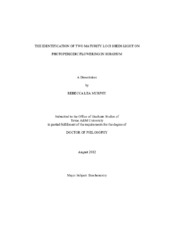| dc.description.abstract | Harnessing the control of flowering time in sorghum bicolor has been essential to programs committed to the development and improvement of this crop. The success of such programs was dependent on the utilization of six Maturity Loci, photoperiod- responsive floral repressors discovered through classic heritability studies. However, the identities of the genes underlying these loci have remained largely unknown. The elucidation of these genes allows for accelerated marker-assisted breeding programs and contributes to the understanding of flowering time in short day plants. Thus, in these studies, two Maturity Loci were identified using a map-based cloning approach, and alleles of each were sequenced in the germplasm. Expression analysis of individual genes by qRT-PCR and the transcriptome by RNAseq was utilized to characterize their response to photoperiod.
Maturity Locus 1 (Ma1), the most effective of the loci, was identified as PSEUDORESPONSE REGULATOR 37, a component of the circadian clock. Sequence analysis revealed an allelic series at this locus, each conferring photoperiod insensitivity to varying degrees. It was demonstrated that the expression of this gene is regulated by the circadian clock, yet also highly dependent on light. Moreover, PRR37 was found to up-regulate floral repressors while down-regulating activators, providing a mechanism of flowering control consistent with the external coincidence model.
Maturity Locus 6 (Ma6) also generated interest through its genetic interaction with Ma1, and was identified as Grain Yield, Plant Height and Heading Date 7 (Ghd7). Sequence analysis of Ghd7 revealed several severe mutations and these were traced through several Milo maturity standards, sweet and bioenergy varieties, as well as the pedigree of lines used heavily in the conversion of tropical sorghum to early flowering types. The expression of Ghd7 mirrors that observed for PRR37 and is also regulated by both light and the circadian clock. PRR37 and Ghd7 together confer greater repression of floral activators than either alone, but do so independently via pathways that converge on the same downstream "florigen". Thus in sorghum varieties with functional alleles of both, floral initiation is delayed indefinitely in long day photoperiods. The identification of these two genes provides a novel perspective on flowering in short day plants, while also accelerating breeding efforts that ultimately result in improved sorghum varieties for food, forage, and biofuels. | en |


